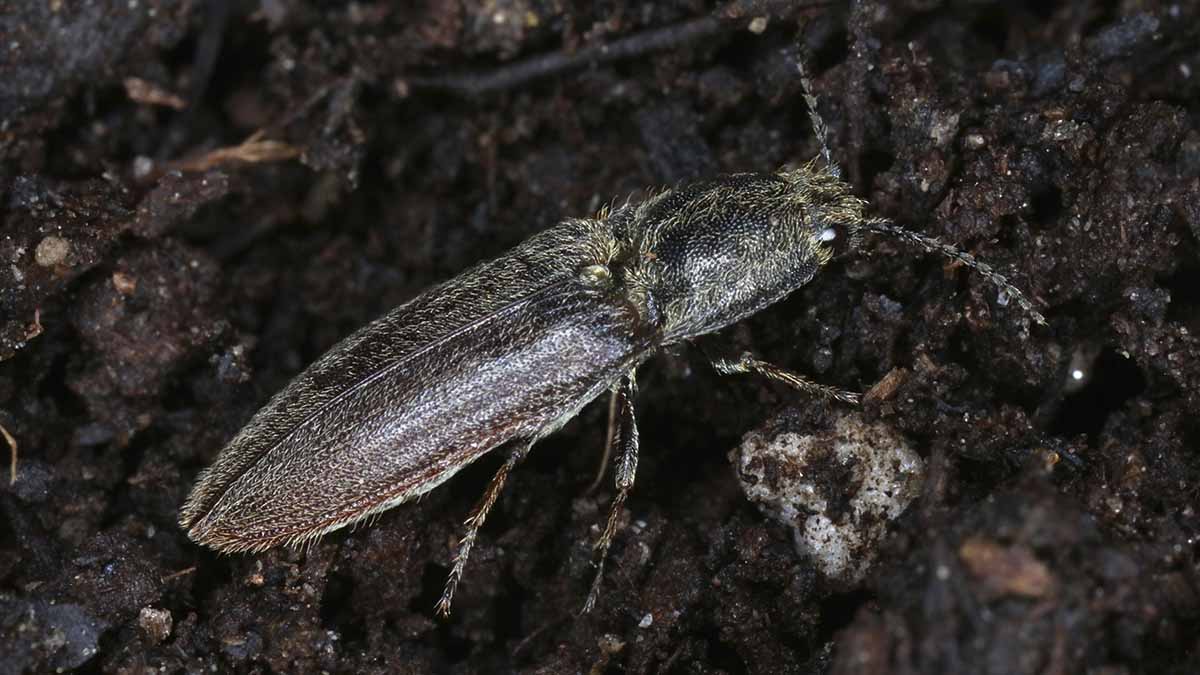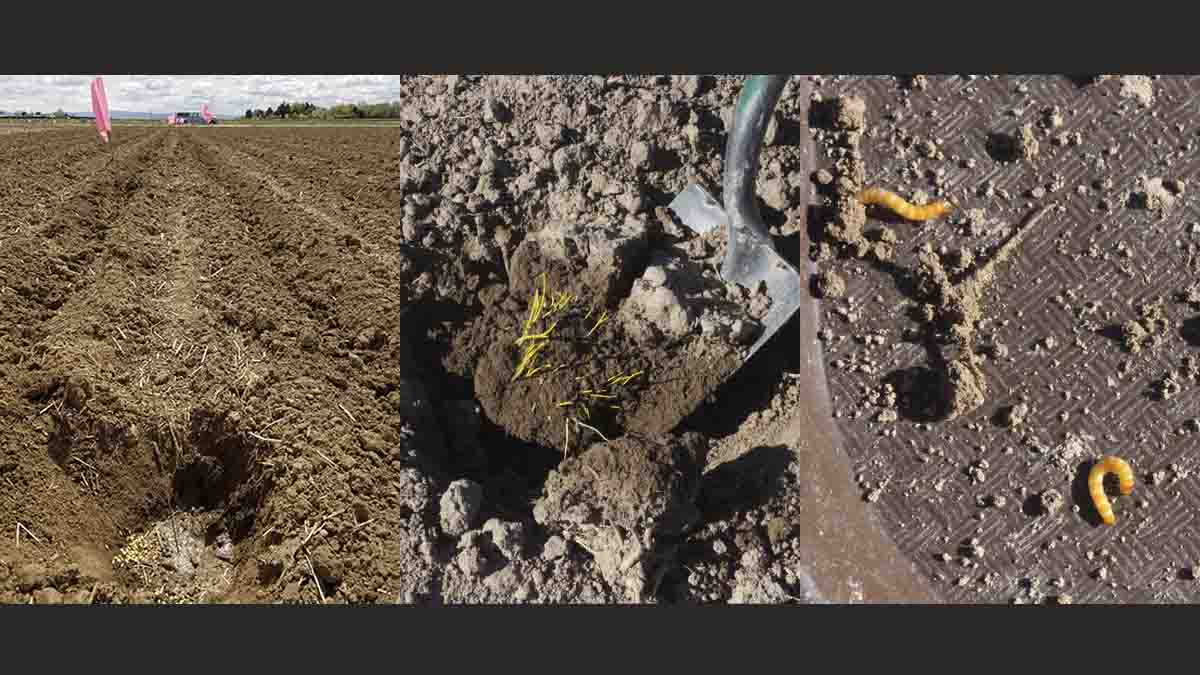Wireworms
Pest Common Name
- Wireworms (Limonius califonicus. L. canus, Selatosomus pruininus and others)
- Affects roots/tubers of plants: potato, sugar beet, onion, carrot, others
- Affects seeds and seedlings of plants: small grains, sugar beet, corn, bean, many others
Wireworms are the soil-dwelling larval form of click beetles (Coleoptera: Elateridae). Click beetles get their name from the sharp “click” noise they produce when they flip into the air (a defensive mechanism and a means of righting themselves when turned onto their back). Adults are narrow-bodied beetles that are generally black or brown in color (Figure 1). Their larvae, wireworms, are slender and cylindrically shaped, and have shiny, slightly hard bodies and small legs (Figure 2). Newly hatched larvae are often white in coloration, but over time larvae darken to become yellow to brown. Though their size differs between species, adults range from 1/4 to 1/2 inch (6-13 mm), and larvae range from 1/2 to 1 1/2 inch (13-38 mm) in length.
Biology
Adults and larvae both overwinter in soil, anywhere from 6-24 inches (15-61 cm) deep. When soil temperatures reach 50-55 degrees Fahrenheit (10-13°C) adults emerge, mate and lay eggs in the top 3 inches (8 cm) of soil. At this time larvae move up in the soil column, to within about 3 inches (8 cm) of the soil surface, to feed. As the season progresses and soil temperatures increase to 80 degrees Fahrenheit (27°C) and above, larvae move deeper in the soil where they will usually remain until the next spring. Wireworms generally take anywhere from two to six years to mature, but eventually larvae pupate within the soil and emerge as adult click beetles. This multiyear lifecycle means that there are often multiple generations of wireworms present in a field at any one time.


Damage
Wireworm feeding on germinating seeds and seedlings can reduce seed viability, weaken stands and generally reduce seedling vigor. Feeding damage can also lead to secondary infection by pathogens.
Monitoring
As with most soil-dwelling insects, wireworms can be challenging to monitor, but soil sampling may aid in detection and assessment of damage risk. Fields that have had wireworm damage in the past, have recently been planted with grasses (e.g., cereals, corn, pasture) or that have had high grassy weed pressure should be prioritized for monitoring efforts as they are more likely to host high populations of wireworms.
To sample soil using the shovel method
Monitoring using this method is most effective after the soil temperature at four inches deep reaches 50 degrees Fahrenheit (10°C) in the spring or when temperatures drop below 80 degrees Fahrenheit (27°C) in the fall (Figure 3).
- Dig up a soil sample about 10 inches deep and 6 inches in diameter
- On a sheet of plastic, sift through soil and count wireworms
- Repeat at least 20 times in different locations around the field, as wireworms are often distributed patchily
- If an average of four or more wireworms per 20 shovel samples is found, economic damage is likely and control is recommended

To sample using the bait trap method
Bait traps should be set before soil temperatures reach 50 degrees Fahrenheit (10°C) at a 4-inch depth, preferably a month before planting.
- Soak untreated cereal or corn seed in water for 24 hours.
- Place about 1/2 cup of seed in a hole about 3-5 inches deep and bury, but do not pack soil
- To increase soil temperature and encourage wireworm activity, lay a piece of black plastic (approximately 1-3 feet square) over the trap location and cover plastic with soil to keep it in place
- Flag or otherwise mark trap
- Place at least 25 bait traps for 30 acres, and at least four traps in fields of less than 30 acres
- Retrieve traps in seven to 14 days
- Collect the bait (soaked seed) and soil immediately surrounding it and sort for wireworms
- Record average number of wireworms per trap and consult the table below for treatment recommendations
Economic thresholds for wireworms in wheat and small grains (Average wireworms per trap — Risk of economic damage — Treatment recommendation)*:
- 0-1 wireworms — Low risk — No treatment
- 1-2 wireworms — Moderate risk — Possible treatment
- 2-4 wireworms — High risk — Treat with recommended rates
- Greater than 4 wireworms — Extreme risk — Extreme methods**
*Note that wireworm distribution is often patchy and trap captures are dependent upon field conditions, so these values should be used only for guidance
**Extreme methods can entail using highest allowable rates of seed-applied insecticides, delaying planting, increasing planting rates or other IPM techniques
Management
Primary Management Tactics
Crop rotation is a cornerstone of effective management of wireworms. At-plant insecticides provide additional crop protection.
Cultural
- Crop rotation is a cornerstone of wireworm management
- Avoiding grasses (e.g., corn, cereals, pasture) for multiple years, especially just prior to a highly susceptible crop such as wheat or barley, can help reduce wireworm pressure in a field
- Including alfalfa, clover or mustards in crop rotations may reduce wireworm populations
- Fallowing a field will subject wireworms to a dry environment lacking in food and reduce populations, but any benefits must be weighed against the loss of production for that field for a season
- Selecting vigorous varieties, with early maturation dates and strong rooting may reduce wireworm damage
- Drying the top 15 inches of soil can target eggs and larvae of sugar beet wireworm and Pacific coast wireworm (Limonius spp.), but this practice may not be compatible with maintaining crops in the field
- Thoroughly saturating the soil for at least two weeks while soil temperatures are above 68 degrees Fahrenheit can increase wireworm mortality, particularly when soil flooding and soil drying are alternated, but this practice may not be compatible with maintaining crops in the field
Biological
- Limiting the use of broad-spectrum pesticides can protect natural predators of wireworms, such as predatory beetles (e.g., predatory ground beetles and rove beetles) and beneficial fungi
- Other natural enemies of wireworms include birds and certain species of nematodes and fungi
Chemical
- There are multiple neonicotinoid seed treatment insecticides that can help control wireworms. This class of insecticides may protect the crop from damage without reducing wireworm populations in the field, which should be considered for subsequent crops in the rotation.
- Other at-plant insecticides may kill wireworms, thus reducing damage and reducing populations
- Treating after wireworm damage is observed is not effective
- Treating one crop in a rotation with a product that kills wireworms can reduce wireworm damage in subsequent years
- Recommendations for pesticides to use in the management of wireworms can be found on the PNW Pest Management Handbooks website
Pesticide Warning
Always read and follow the instructions printed on the pesticide label. The pesticide recommendations in this University of Idaho webpage do not substitute for instructions on the label. Pesticide laws and labels change frequently and may have changed since this publication was written. Some pesticides may have been withdrawn or had certain uses prohibited. Use pesticides with care. Do not use a pesticide unless the specific plant, animal or other application site is specifically listed on the label. Store pesticides in their original containers and keep them out of the reach of children, pets and livestock.
Trade Names — To simplify information, trade names have been used. No endorsement of named products is intended nor is criticism implied of similar products not mentioned.
Groundwater — To protect groundwater, when there is a choice of pesticides, the applicator should use the product least likely to leach.
- Erik J. Wenninger, University of Idaho
Desiree Wickwar, Entomologist, IPM Project Manager
Erik J. Wenninger, Professor of Entomology, IPM Coordinator
2023









